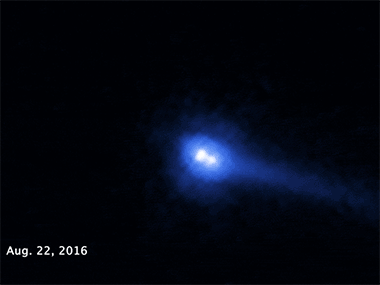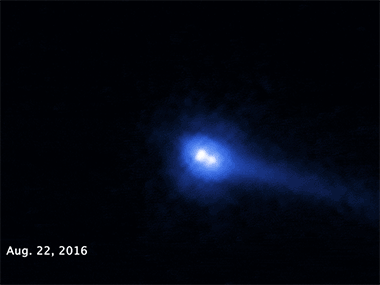An unusual object, discovered in the solar systems asteroid belt, is actually two asteroids orbiting each other, scientists including one of Indian origin have found using the Hubble Space Telescope. The object has comet-like features including a bright halo of material, called a coma, and a long tail of dust. Hubble was used to image the asteroid, designated 300163 (2006 VW139), in September 2016 just before the asteroid made its closest approach to the Sun. [caption id=“attachment_4067623” align=“alignleft” width=“380”]  Image: NASA[/caption] The images revealed that it was actually not one, but two asteroids of almost the same mass and size, orbiting each other at a distance of 96 kilometres. Asteroid 300163 (2006 VW139) was discovered by Spacewatch in November 2006 and then the possible cometary activity was seen in November 2011 by Pan-STARRS. Both Spacewatch and Pan-STARRS are asteroid survey projects of NASA’s Near Earth Object Observations Program. After the Pan-STARRS observations it was also given a comet designation of 288P. This makes the object the first known binary asteroid that is also classified as a main-belt comet. The more recent Hubble observations revealed ongoing activity in the binary system. “We detected strong indications for the sublimation of water ice due to the increased solar heating - similar to how the tail of a comet is created,” said Jessica Agarwal of the Max Planck Institute for Solar System Research in Germany. The combined features of the binary asteroid - wide separation, near-equal component size, high eccentricity orbit, and comet-like activity - also make it unique among the few known binary asteroids that have a wide separation. Understanding its origin and evolution may provide new insights into the early days of the solar system. Main-belt comets may help to answer how water came to a bone-dry Earth billions of years ago. The team estimates that 2006 VW139/288P has existed as a binary system only for about 5,000 years. The most probable formation scenario is a breakup due to fast rotation. After that, the two fragments may have been moved further apart by the effects of ice sublimation, which would give a tiny push to an asteroid in one direction as water molecules are ejected in the other direction. The fact that 2006 VW139/288P is so different from all other known binary asteroids raises some questions about how common such systems are in the asteroid belt. “We need more theoretical and observational work, as well as more objects similar to this object, to find an answer to this question,” said Agarwal. The research appears in the journal Nature.
The object is the first known binary asteroid that is also classified as a main-belt comet.
Advertisement
End of Article


)



